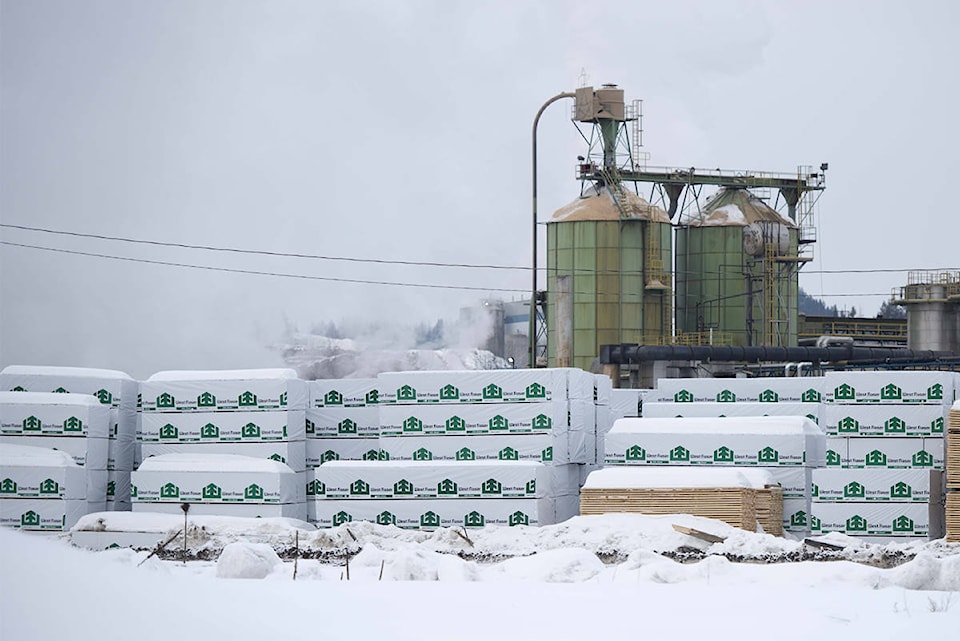City of Quesnel council received an update regarding West Fraser’s Quesnel fibre supply and operations from regional manager D’Arcy Henderson and woods manager Stuart Lebeck on Feb. 27.
Henderson provided an overview of the operations, fibre access, residual chip, and residual sawdust and shavings supplies.
(See the March 7 edition of the Quesnel Cariboo Observer for details on fibre, chips, and sawdust and shaving supply demands.)
Noting the lowering trends in the Annual Allowable Cut of fibre, the general manager said West Fraser leans on its competitiveness and its ability to utilize logs that come into Quesnel for the highest valued products – whether it’s for panels or lumber.
The lumber giant is also able to compete for fibre outside the Quesnel region.
Region-wide impacts
Henderson said West Fraser is looking very closely at the reduction of the mountain pine beetle killed wood and the impact of last summer’s wildfires in all of its divisions across the Cariboo.
“Williams Lake [51 per cent] and 100 Mile House [50 per cent] are the most significantly impacted by the mountain pine beetle. There is some more diversity in the forests there with the Douglas-fir, so the impact and reduction in the harvest level is slightly less than Quesnel [60 per cent].
“This is our TSA [Timber Supply Area] and not our TFL [Tree Farm Licence].”
He added the recent wildfires may change those percentages, but they haven’t received the provincial government inventory numbers.
“We’re working closely with them and one of our chief foresters Jeff Mycock’s key initiatives is to work through that with the government and our local woodland groups.”
Lebeck noted the Allowable Annual Cut (AAC) was up to 4,000,000 cubic metres (m3) until June 2017, when the provincial chief forester announced the new volume at 2.6 million m3.
“But then we had the wildfires, so the live and dead conifer cuts for deciduous are back to the evaluation mode… Ministry of Forests decided to have another look at the pine timber types within the Quesnel TSA.
“We did expect to have some inventory numbers from the ministry by December, but it was deferred until early in 2018, which is now, so they should be coming soon.”
Lebeck added 1.6 million m3 is a number they expected.
“It could be 1.25 million m3, but 1.6 million m3 is what we’re currently expecting.”
Quesnel Councillor Ed Coleman asked about West Fraser’s commercial trimming process in its TFL.
Lebeck said it’s a stand density management treatment, taking plantation fibre at a certain harvest level to bring it down to a density level that will allow it to grow better in the latter part of its growth period.
“It’s an Eastern Canadian master process. It’s a European long-term process they use.
“It’s one opportunity for us to grow sawlogs, pulp and biomass, while actually improving our stands for the final harvesting.”
He added it’s early, but it’s going well.
Lebeck said it is a process that would work with wildfire interface fuel management.
“There’s a fuel management project on Kluskus Indian Reserve that we’re partnering with them on, and perhaps another location.”
With shrinking fibre availability, Coun. Ron Paull asked if there was an opportunity for a small business to salvage some of the mountain pine beetle killed or fire damaged wood in the Chilcotin?
Lebeck said the fire intensity experienced west of Quesnel compared to Williams Lake or 100 Mile House means there is a gradient of severity.
“We experienced a very hot, damaging fire west of Quesnel. The economics from a sawlog perspective, they won’t make sawlogs and they won’t make chips because of the burnt content.
“So, if there is an opportunity for other secondary manufacturing to utilize that fibre… maybe for pellets or biomass.”
He added it may be too early to analyze the material that’s left in the forests: “We weren’t allowed access to mid-winter.”
Noting Norway and Finland used to be the go-to people for the re-forest industry and sawmill technology, Coun. John Brisco asked if West Fraser is a little behind or ahead now?
Henderson said West Fraser still sends people to Europe and around the world.
“We have experimented with the physical equipment within the European mills.
“We’re confident we get a better utilization of fibre recovery for higher value products with our operations to date with equipment Canadian manufacturers supply.”
